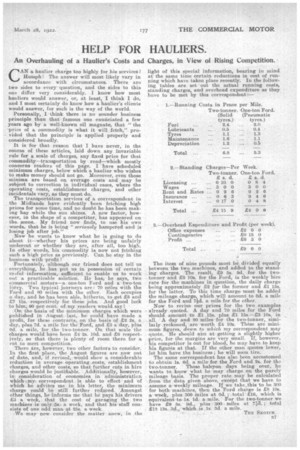HELP FOR HAULIERS.
Page 25

If you've noticed an error in this article please click here to report it so we can fix it.
An Overhauling of a Haulier's Costs and Charges, in View of Rising Competition.
CAN a haulier charge too highly for his services.? Humph! The answer will most likely vary in accordance with circumstances. There are two sides to every question, and the sides to this one differ very considerably. I know how most hauliers would answer, or, at least, I think I do, and I most certainly do know how a haulier's clients would answer, for such is the way of the world.
Personally, I think there is no sounder business principle than that famous one enunciated a few Years ago by a well-known oil magnate, that "the price of a commodity is what it will fetch," provided that the principle is applied • properly and considered broadly.
It is for that reason that I have never, in the course of these articles, laid down any invariable rule for a scale of charges, any fused price for that commodity-transportation by road-which mostly concerns readers of this page. I have scheduled minimum charges, below which a haulier who wishes to make money should not go. Moreover, even those minima are based on average costs and may be subject to correction in individual eases, where the operating costs, establishment charges, and other incidentals vary, as they must do. The transportation services of a correspondent in the Midlands have evidently been fetching high pries,* for some time, and no doubt he haa been making hay while the sun shines. A new factor, however, in the shape of a competitor, has appeared on the scene. My friend now finds, to use his own words,that he is being "seriously hampered and is losing jab after job."
Now he wants to know what he is going to do about it-whether his prices • are being unfairly undercut or whether they are, after all, too high. In other words, his commodity is now not fetching such a high price as previously. Can he stay in the business with profit?
Forttinately, although our friend does not tell us everything, he has 'put us in possession of certain useful information, sufficient to enable us to work out a practicable solution. He has he says, two esnintercial motors-a o.ne-ton Ford and a two-ton lorry. Two typical journeys are : 70 miles with the Ford.and 80 miles with the other. Each occupies a day, and he has been able, hitherto, to get 25 and £7 15s. respectively for these jobs. And good luck to him, 90 per cent. of nay readers would.say ! •
On the basis of the minimum charges which were published in August last, hecould have made a profit, for these contracts, on the basis of 22 28. a day, plus 7d. a mile for the Ford; and £3 a day, plus ed. a mile, for the two-tonner. On that scale the charges would have been 24 2s. I0d. and 26 respectively, so that there is plenty of room there for a cut to meet competition.
There are, however, two other factors to consider. In the first place, the August figures are now out of date, and, if revised, ,would show a considerable reduction in average operating:oasts, establishment charges, and other costs, so thatfurther, cuts in hire charges would be justifiable. Additionally., however, in consideration of economies in administration which smy:correspondent is able to 'effect and of which he advi§es me in his letter, the minimum charge could be still further reduced. Amongst other things, he informs me that he pays, his drivers 23 a week, that the cost of garaging the two machines is onlys5se a week, and that his staff consists of one odd manat 25s. a week.
-Wemay now consider the matter anew, in ,the light of this special information, bearing in mind at the same time certain reductions in cost of running which have taken place recently. In the following tables are set • out the actual running costs, standing charges, and overhead expenditure as they have to be met by this correspondent: The item of nine pounds must be divided equally between the two machines, and added to. the standing. charges. The result, 29 5s. 9d. for the twotonna. and 28 Ns. for the Ford, is the weekly hire rate for the machines in question, the daily charge being approximately 22 for the former and 21 15s. for the latter. To this time charge must be added the mileage charge, which will amount to 6d. a mile for the Ford and Id. a mile for the other.
Now to revise our prices for the two examples already quoted. A day and 70 miles for the Ford should amount to 21 15s. plus 21 15s.-23 10e. in all. A day and 80 miles for the two-tonner, similaily reckoned, are worth 24 10s, These are minimum figures, down to which my correspondent may quote. He should aim at getting a slightly higher price, for the margins are very small. If, however, his competitor is out for blood, he may have to keep his figures at that. If the other man quotes lower, let him have the business ; he will soon tire. The same correspondent has also been_ accustomed to obtain-Is. 6d, a mile for. the Ford and. 2s. for the two-tonner. Those halcyon days being over, he wants to_ know what he ma.y charge on the purely mileage basis. The proper rate may be calculated from the data given above, except that we have to assume as Weekly mileage. If we takesthis to be 300 for both machines, then the Ford charge is 28 10s. is week, plus 300 Miles at 6d. ; .total 216, which is equivalent-to-is. Ids amile.. For the two-tonner we have 29 5s. 9d., .plus s 300 miles at 70. ;total 218 13s. 30., which es ,ls. 3d. a mile.
THE' SKOTCH . •
































